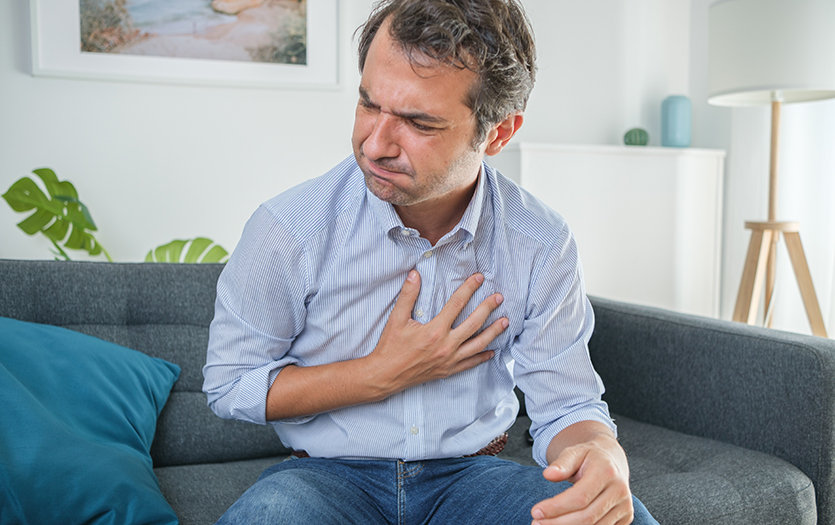
This post was written by Megan Lauer, NP, Virtual Walk-in Clinic, Parkview Health.
Despite its name, "heartburn" has nothing to do with the cardiac organ. The term relates to the burning sensation felt behind the mid-chest area. For most people, occasional heartburn is a common symptom of acid reflux. However, frequent episodes or manifestations that do not resolve with home treatment may be a cause for concern.
Causes
Heartburn occurs when stomach acid flows back into the esophagus. It can happen when you bend over or lie flat, as the acid puts extra pressure on the sphincter at the stomach's opening, leading to the discomfort associated with heartburn.
Certain foods, especially when eaten late at night, can trigger heartburn. This can include:
-
Large or fatty meals
-
Rich foods like chocolate and peppermint (menthol)
-
Carbonated, caffeinated or alcoholic beverages
-
Spicy or acidic foods and drinks
In addition to dietary triggers, other factors that can contribute to a weaker esophageal sphincter and lead to increased heartburn include:
-
Smoking and exposure to second-hand smoke
-
Aging
-
Certain medications
Symptoms
Along with a burning sensation in the upper abdomen and chest, heartburn may also be accompanied by burping, nausea, bloating or trouble swallowing. These symptoms often worsen after eating, when bending over or lying flat in bed for the night.
Some individuals may experience a bitter or sour taste in their mouth when lying down, which can sometimes persist into the morning.
Heartburn can also disrupt sleep, occasionally causing regurgitation (when stomach contents come up), leading to a burning sensation or irritation in the back of the throat. Depending on digestion, this discomfort can range from mild to severe and may last minutes to hours.
Effects of frequent heartburn
Recurring episodes of heartburn can damage the esophagus and cause long-term complications such as:
-
Esophageal strictures (abnormal narrowing of the esophagus)
-
Intestinal metaplasia (cellular changes in the esophagus)
-
Stomach ulcers and gastroesophageal reflux disease (GERD)
-
Increased risk of esophageal cancer due to inflammation and cellular damage
Treatment
Simple lifestyle modifications such as avoiding triggering foods, consuming smaller meals and not lying down immediately after eating can help prevent heartburn flare-ups. Over-the-counter medications can help manage discomfort and protect the esophagus from further irritation if symptoms persist.
-
Antacids like Tums® and Rolaids® quickly neutralize stomach acid and provide immediate relief. These medications are intended for occasional heartburn relief only. Frequent use of antacids may lead to undesired side effects.
-
Histamine receptor antagonists (H2 Blockers), like Pepcid AC®, suppress stomach acid production. They offer longer-lasting relief from symptoms than antacids. Taking them before consuming foods or beverages that trigger heartburn can help minimize symptoms.
-
Proton pump inhibitors (PPIs), like Prilosec®, block acid production more effectively and promote tissue healing. Avoid using them for more than 14 days without consulting a healthcare provider.
When to seek medical attention
Heartburn and heart attacks can cause similar chest discomfort, making it difficult to distinguish between the two. This can be especially true for women, who often describe experiencing only a dull ache or tightness in the chest rather than intense pain.
Seek emergency care immediately if you experience any combination of these symptoms:
-
Persistent chest pain or pressure
-
Pain that spreads to the jaw, neck, arm, back or abdomen
-
Shortness of breath
-
Unexplained fatigue
-
Profuse sweating or chills
-
Dizziness
Other signs that may accompany heartburn that warrant a medical evaluation include:
-
Increased frequency or worsening heartburn symptoms
-
Acid reflux symptoms that do not improve despite medication
-
Unintentional weight loss
-
Difficulty swallowing
-
Persistent nausea or vomiting
A convenient care option
Parkview MyChart makes it quick and easy to receive care for common issues such as heartburn with E-Visits. E-Visits use a symptom-based questionnaire to diagnose and provide treatment for several common conditions – no appointment or video visit is needed. It only takes a few minutes to complete the questionnaire and one business day, excluding weekends, to receive a personalized treatment plan from a Parkview provider including prescription medication, if needed. Find more about E-Visits here. To get started, download the free MyChart app, log in to your account and tap E-Visit.
Without a Parkview MyChart account?
Call our MyChart Support Team at 260-266-8700 or toll-free 1-855-853-0001, email MyChart@parkview.com or create an account here. It is free, available to all Parkview patients, and accessible anytime, anywhere in the United States via the web or mobile app: Apple | Android



